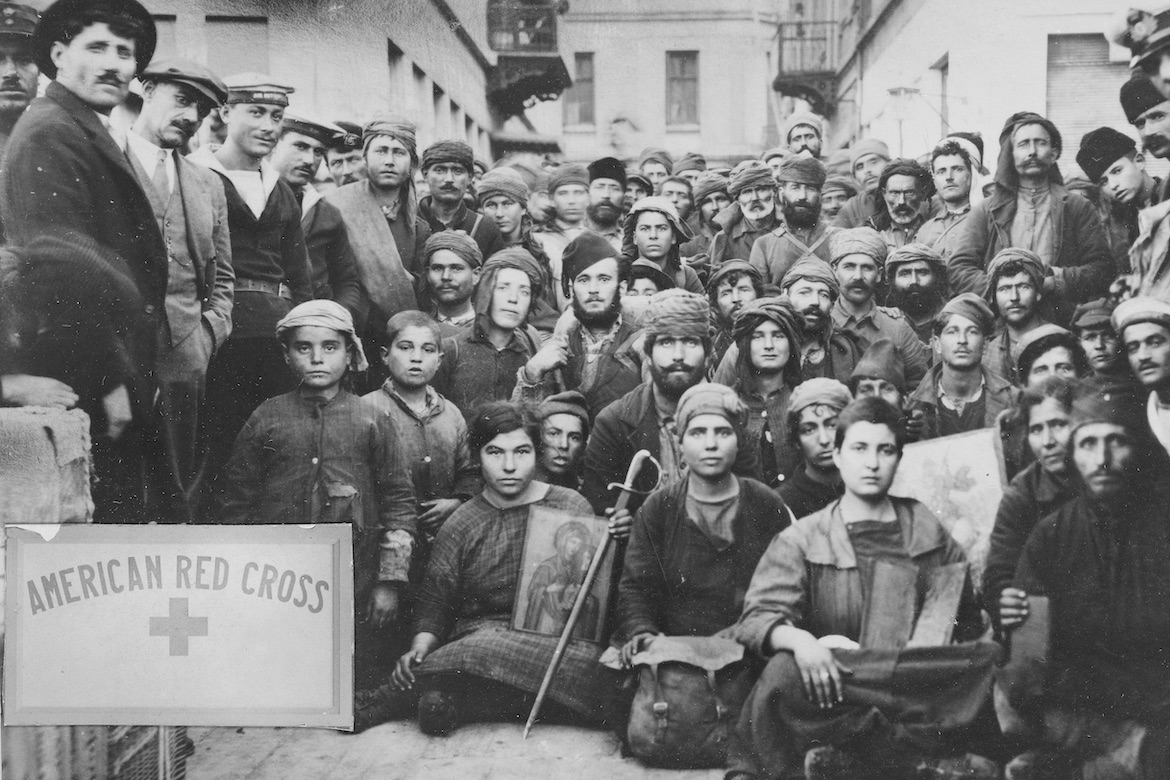In the photo, above, these villagers from Asia Minor were driven into the mountains near their homes shortly after the 1922 Smyrna fire. For three and a half months they lived on grass and roots, occasionally raiding an olive grove by night.
According to verbal testimony, two members of the group stole a fishing boat and safely shuttled everyone down the mountain in the middle of the night. Then they escaped to the Greek island Chios.
In the photo, the group is receiving food and clothing from the American Red Cross at a facility in Chios. The photo comes from the United States Library of Congress.
Family heirlooms, icons and other beloved possessions appear in the picture. The refugees had carried the items with them on the journey across the water.
Although ethnically Greek, the Asia Minor refugees faced severe discrimination upon their arrival in “Mother Greece.”
Many of them spoke Turkish as their native language and, although Greek Orthodox Christians in faith, even their worship style differed from their brothers and sisters in Greece.
Their strangeness scared the native Greeks and nativist elements in Greece helped stoke fear — even hatred — against the Greek refugees from Turkey.
Politicians argued to close the country’s borders while right-wing newspapers called the incoming hordes of people a “threat” to the Greek way of life, referring to refugees as “Tourkosporoi” or “Turk-offspring.”
The anti-immigrant anti-refugee rhetoric of the time referred to the new arrivals as rodents that had infested the streets and town squares of Greece’s cities and ports.
Because of the Greek nation’s inability to respond to millions of new arrivals, foreign relief agencies such as the American Red Cross, the American Women’s Hospitals and the Near East Relief Association mobilized. The agencies set up tent cities in parks around ancient temples and away from objecting residents.
On October 13, 1922, Dr. A. Ross Hill, vice chairman in charge of foreign operations for the American Red Cross, sailed for Greece to organize the agency’s work in support of the struggling Greek government.
These agencies proved critical in providing life-saving support for hundreds of thousands of people throughout Greece. They set up makeshift hospitals and orphanages that treated hundreds of thousands of patients and saved tens of thousands of lives.
The agencies built housing in Athens, Thessaloniki and other Greek cities. People from various walks of life herded into refugee ghettos. These groups included farmers from Aivali’s fertile fields, aristocratic families from Smyrna and fig merchants with multilingual children who attended private boarding schools.
According to American Red Cross sources, during the winter months of 1922 the organization fed as much as 116 million rations to 860,000 people per day.
The Red Cross opened 142 feeding stations and 160 distribution points throughout the country and distributed nearly 24,000 tons of food, clothing, blankets and shoes.
In cooperation with the Greek government, the American Red Cross devised a plan of medical relief for the refugees that equipped 59 hospitals, supplied 1751 hospital beds, treated 9781 patients and opened 71 ambulatories where they treated no less than 233,454 cases.
The organization combated typhus, smallpox, typhoid, malaria and other contagious diseases. In conjunction with other agencies, its Sanitary Program encompassed vaccinations, inoculations of paratyphoid, typhoid and cholera. The program also established delousing and bathing stations where an estimated 400,000 patients received treatment.
Photos and Captions from the Archives of the American Red Cross

These villagers of Asia Minor were driven into the mountains near their homes shortly after the Smyrna debacle. For three and a half months they lived on grass, roots and similar food, occasionally raiding an olive grove by night. Finally two bold members stole a small boat and escaped. The whole party is now being fed and clothed by the American Red Cross. Icons and other possessions commonly brought are shown in the picture.

During the spring months, the ARC anticipating the danger of typhus and other contagious diseases, kept prepared several tents for the purpose of isolating any case that might be found This proved to be a wise precaution, and thanks to such effective means as this, all epidemics were successfully kept down on the Isle of Chios. The above picture shows an isolation ward maintained at Chios. The Red Cross had two such wards, supervised by the American Women’s Hospitals.

The milk stations were by far the most important work of the Red Cross, as they were entirely responsible for saving the lives of thousands of babies. At one milk station alone in the dangerous spring months, the total fed on the whole island reached as high at times as 3000.

The American Red Cross by dint of sheer persistence, succeeded in establishing feeding, medical and sanitary centers in the heart of the mountains, where many refugees had wandered. Even the Greek government itself had not reached these people for months after the Red Cross had catalogued and was feeding them. The picture shows the baby milk feeding station at the village of Thimiana, on the Isle of Chios, which is the center of that section of the island.

Five thousand refugees have received soup daily at Chios since January, Besides the bread given these people, the soup constituted their only food. Thousands owe their lives to this distribution. The building employed is an old Turkish mosque.















